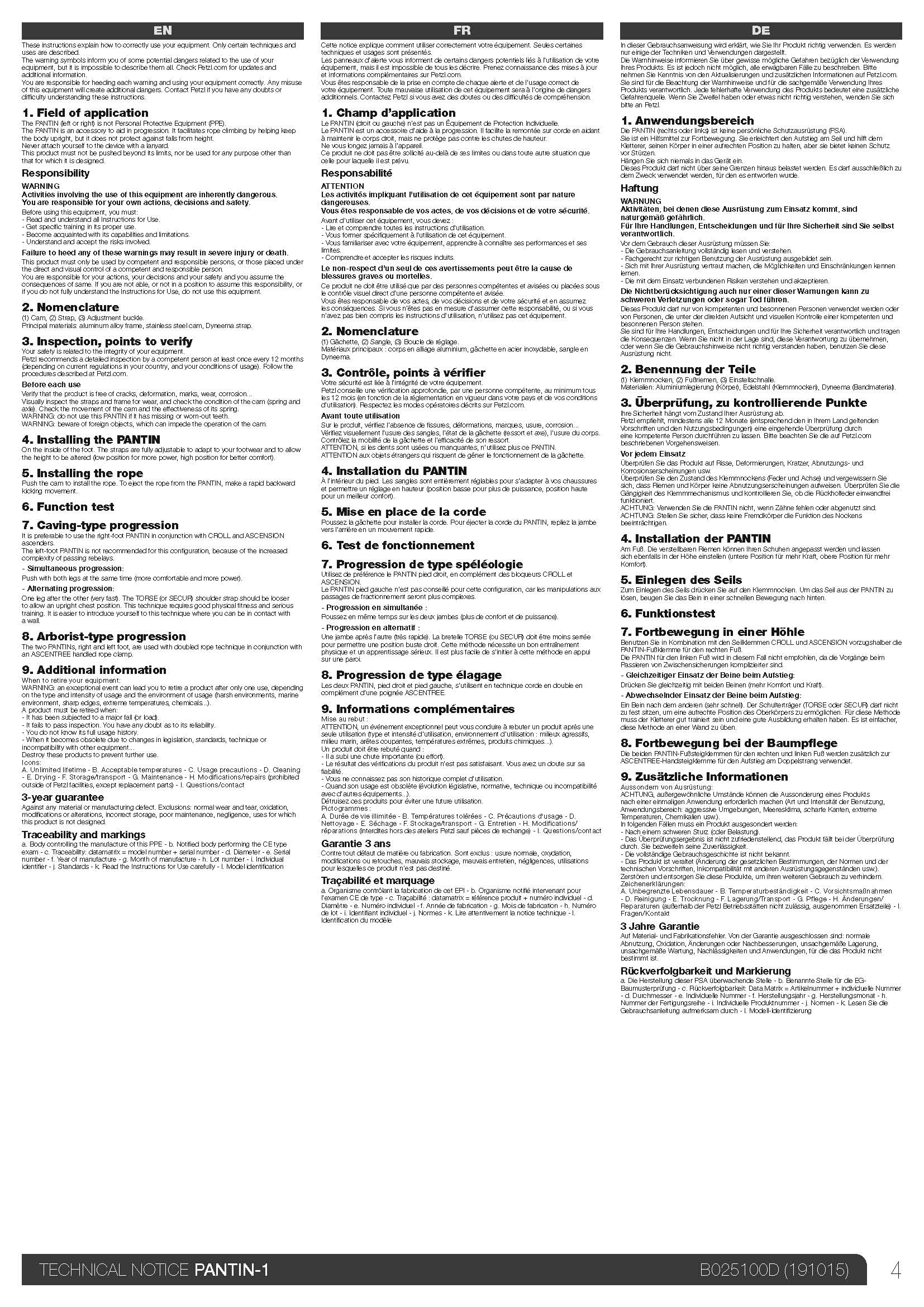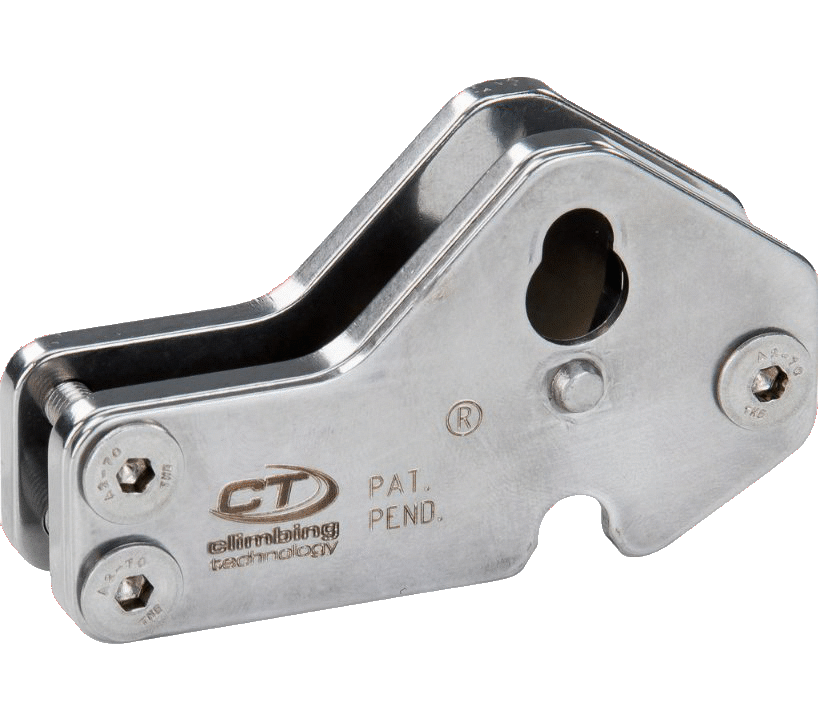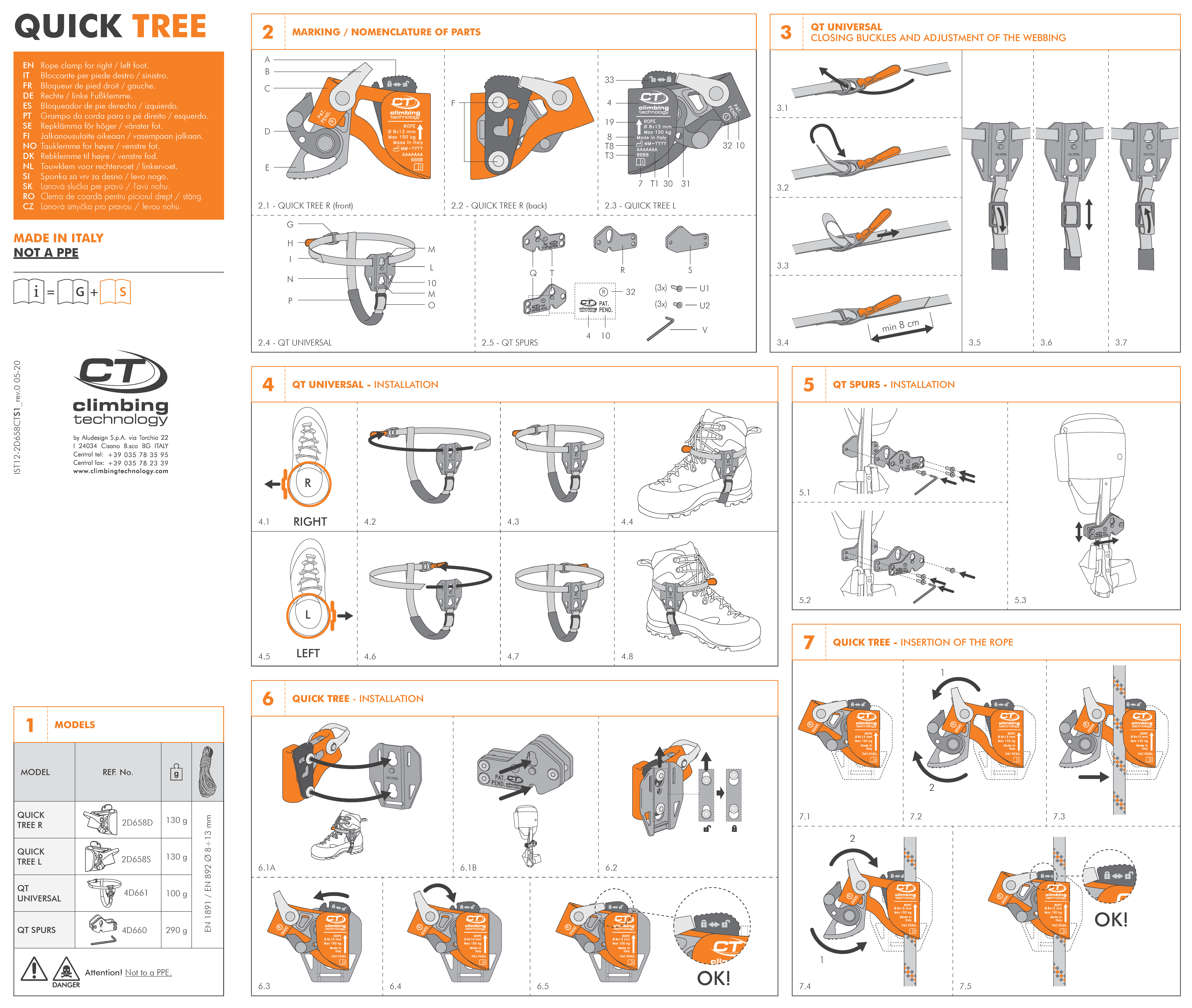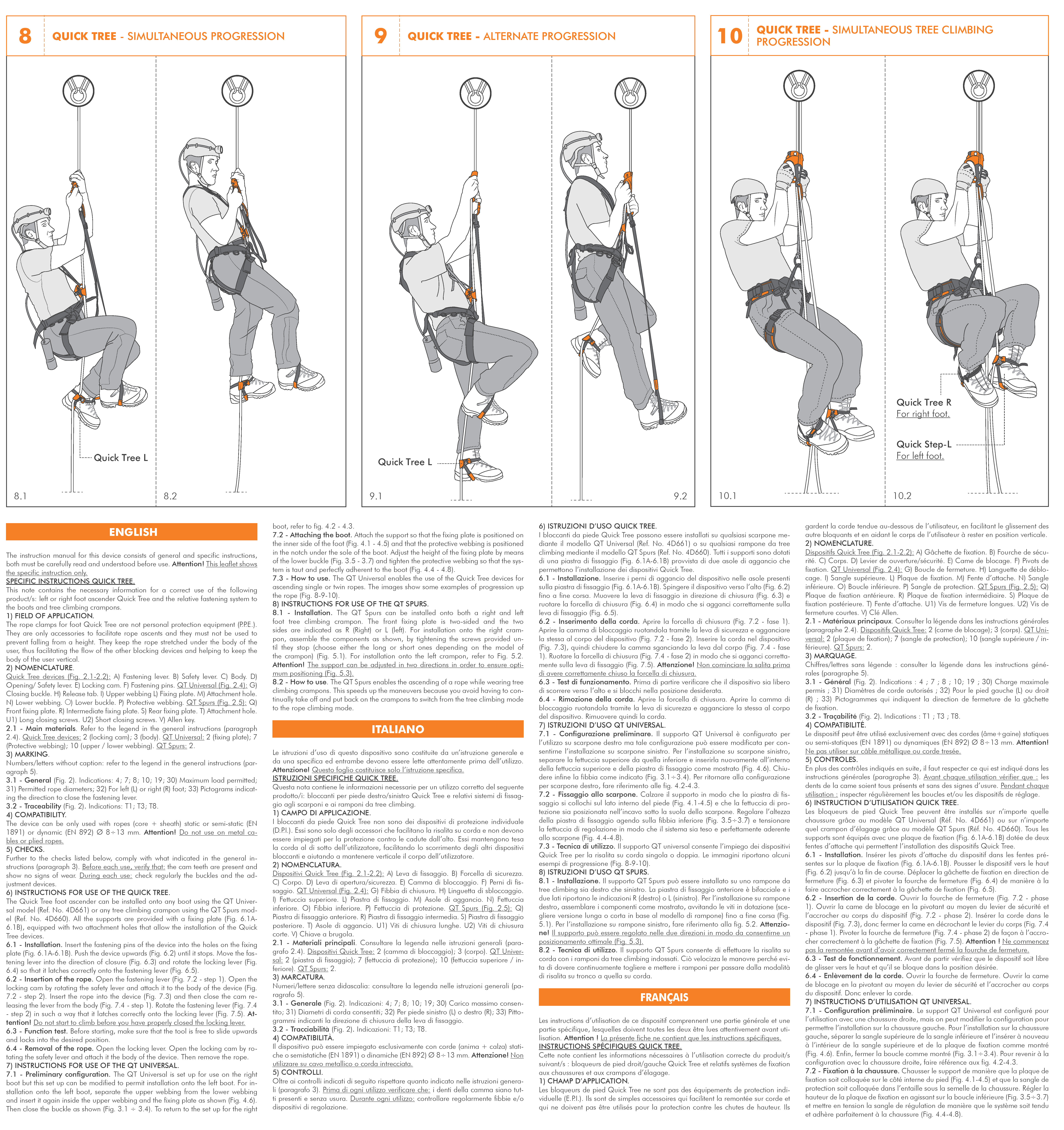Overview
[ Top
| Quick Step, Version B
| Quick Tree
| Return to Foot Ascenders
]
Quick Step, Version A
(#1949, 2231/2232)
Technical Details
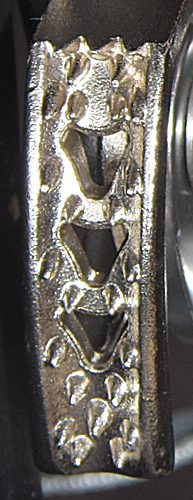 I acquired a left-foot ascender from Knot & Rope Supply from Amazon.com in 2013. I acquired another left and a right in 2017 as part of Bob Thrun’s collection. In 2025 I obtained another left-foot ascender from Divine Associates.
I acquired a left-foot ascender from Knot & Rope Supply from Amazon.com in 2013. I acquired another left and a right in 2017 as part of Bob Thrun’s collection. In 2025 I obtained another left-foot ascender from Divine Associates.
The ascender consists of a stamped, anodized aluminum
shell, a cam assembly, and a set of straps and buckles. It is 51 mm. tall, 73 mm. wide, 27 mm. thick, and weighs 130 g. bare and 165 g. including the harness. The rope channel is 15 mm. wide, and is 50 mm. from
the cam pivot. The cam is spring-loaded and has a (3.2.4)(1H1.2)^3(3.2) tooth
pattern. The cam radius increases from 37 to 55 mm. over an angle of 42°, giving a 28° cam angle. A spring-loaded manual safety
hook is attached to the side of the cam. The normal action of
the spring holds the safety against the cam. When the cam is opened,
the shell interferes with the safety hook, thus preventing opening
the cam. If the safety hook is moved away from the cam (opposing
the spring), it will clear the shell and the cam will open. At
full open the safety can be released and the spring will hold
the safety against the back of the shell. This provides a means
of locking the cam open. A pin on the safety assists in operating
the safety mechanism. Slots in a separate plate riveted to the back of the shell accept
webbing straps. An ankle strap slides freely, and an under-foot
strap is sewn in place. Both straps have adjustment buckles.
The front of the ascender is printed with the Climbing Technology logo, "climbing technology," an arrow pointing up, "ROPE," "Ø 8÷13 mm," "Max 150 kg," "Made in Italy," a book-with-an-"i" icon, an "L" inside a circle ("R" on the right foot ascender), and "0112."
My first one was clearly a Climbing Technology Quick Step ascender, but it was repackaged in Knot & Rope packaging.
I am not sure why Climbing Technology chose to have a separate plate for attaching the straps, instead of using slots in the shell like several others do. Perhaps it was due to patent issues, but perhaps the reason is more functional. Some other foot ascenders can have the cam bind on the lower strap if that strap is loose, while the separate plate on the Quick Step helps prevent this from happening.
Foot ascenders such as this don't fit into the climbing systems that I commonly use, although I have met froggers that seem to like them. The CMI cam safety keeps the cam from opening accidentally. The Climbing Technology is nicely made, and if you take time to learn it, it should work well.
[ Top
| Quick Step, Version A
| Quick Tree
| Return to Foot Ascenders
]
Quick Step, Version B
(#2300/1986)
Technical Details
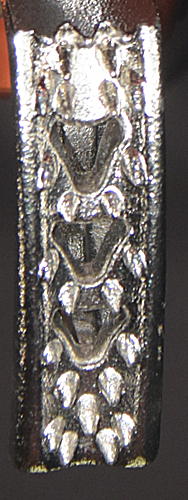 I acquired my right-foot Version B from Expé-Spelemat in 2014. The left-footed one is somewhat of a cheat created for display purposes: I acquired a Version A from Pinnacle Arborist Supplies through Amazon.com in 2017, and removed the safety from the cam.
I acquired my right-foot Version B from Expé-Spelemat in 2014. The left-footed one is somewhat of a cheat created for display purposes: I acquired a Version A from Pinnacle Arborist Supplies through Amazon.com in 2017, and removed the safety from the cam.
Quick Step, Version B is 51 mm. tall, 73 mm. wide, 27 mm. thick, and weighs 125 g. Version B omits the cam safety.
The markings on my Version B are the same as on my Version A except that the front has "R" inside a circle instead of "L" and "0314" instead of "0112."
Some other foot ascenders like the Petzl Pantin, lacked safeties. When first playing with these, I found that each step caused the ascender
to come off the rope. Improved technique solves the problem. Strictly speaking, the safety is not necessary, but some folks my prefer to have one and will miss its omission on this version.
[ Top
| Quick Step, Version A
| Quick Step, Version B
| Return to Foot Ascenders
]
Quick Tree & QT Universal
(#2947/2948 & 2949)
Technical Details
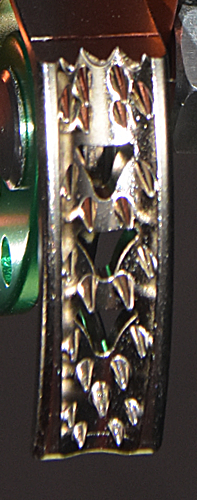 I acquired my Climbing Technology Quick Tree ascenders and QT Universal harness from TreeStuff.com in 2019.
I acquired my Climbing Technology Quick Tree ascenders and QT Universal harness from TreeStuff.com in 2019.
The Quick Tree ascender comes in left- and right-foot versions. The QT Universal harness fits either ascender. The three are sold separately.
Quick Tree ascender
The Climbing Technology Quick Tree ascender is 64 mm. tall, 73 mm. wide, 32 mm. thick, and weighs 133 g.
The shell is stamped from 3.8 mm. aluminum alloy and soft anodized. There is a U-shaped rope channel on the left side of the left foot ascender (right on the right). The rope channel is 15 mm. wide. The shell angles upwards and terminates in a cam channel opposite the rope channel. A rivet passing through this channel acts as a cam axle and also a pivot for the attachment lock. This rivet is 50 mm. from the inside of the rope channel.
The cam is forged from stainless steel. The cam radius increases from 37 to 55 mm. over an angle of 42°, giving a 28° cam angle. The tooth pattern is (3.2.4)(1H1.2)^3(3.2). A spring-loaded manual safety
hook is attached to the side of the cam. The normal action of
the spring holds the safety against the cam. When the cam is opened,
the shell interferes with the safety hook, thus preventing opening
the cam. If the safety hook is moved away from the cam (opposing
the spring), it will clear the shell and the cam will open. At
full open the safety can be released and the spring will hold
the safety against the back of the shell. This provides a means
of locking the cam open. A pin on the safety assists in operating
the safety mechanism.
An attachment latch assembly is riveted to the rear of the shell, behind the rope channel. This assembly allows connecting the ascender to the plate of the QT Universal harness. It also allows the ascender to be attached to Climbing Technologies QT Spurs, a device that allows mounting the ascender on tree climbing spurs. The assembly consists of a pivoting latch and a spring plate between the bar and the shell. The latch pivots on the lower rivet, and has a slot to allow motion with respect to the upper rivet. Between the two there is an L-shaped hole that engages a locking pin on the Universal harness plate or the QT spurs. The rivet heads sit proud of the swinging latch, where they can engage slots in the QT Universal plate or QT Spurs as desired. The spring plate has a small tab with a dimple that provides friction when swinging the latch. A stamped U-shaped safety pivoting on the cam axle can be rotated to engage a notch in the top of the swinging plate, helping to hold it in the locked position.
The front of the rope channel is printed with the CT logo, "climbing technology," an up-pointing arrow, "ROPE Ø 8÷13 mm," "Max 150 kg," "Made in Italy," "PAT. PEND., a book-with-an-"i" icon, and "0319". The cam channel is printed with "LEFT" or "RIGHT" as appropriate. The front of the pivoting latch is printed with an open lock icon, "↔," and a closed lock icon. The rear of the cam is stamped with "I" and "1."
QT Universal
The QT Universal consists of a stamped metal plate and a sewn webbing harness. The plate is stamped from 1.9 mm. stainless steel. The plate is 70 mm. tall, 59 mm. wide and 6 mm. thick. A central rectangular channel (concave toward the foot) provides reinforcement as well as clearance for the ascender mounting rivets and the lower foot strap. Two holes with slots above engage the attachment rivets on the Quick tree. A pin below the upper hole engages the L-shaped slot on the Quick Tree attachment latch. When the latch is in the locked position, this pin prevents removing the ascender.
The harness is made from 15 mm. flat webbing and a two-piece metal buckle assembly equipped with a plastic pull. One strap circles the ankle, and another passes under the foot. The under-foot strap slides freely on the ankle strap, allowing one to reverse the ankle strap if one prefers to have the buckle work in the opposite direction. A piece of tubular webbing slid over the underfoot strap provides some additional abrasion protection.
The plate is stamped with "PAT. PEND."
Quick Tree and QT Universal together
To attach the Quick tree to the QT Universal, perform these steps:
- Raise the U-shaped latch safety so that it clears the slot in the latch.
- Swing the latch to the unlocked position.
- Align the latch assembly rivet heads with the QT Universal Plate and press inward.
- Slide the ascender upward.
- Swing the latch to the locked position
- Lower the latch safety so that it engages the latch notch.
The Quick Tree and associated accessories are designed for the arborist community. Not being Tarzan, I'll let arborists evaluate it for that use on their web sites.
I normally use this type of foot ascender in any of my normal caving or climbing rigs, but some people do. Since I don't need this type of ascender, I also don't need the ability to remove the ascender from my foot harness. I won't speak for the arborists, but I don't think most cavers or climbers need this feature. That said, in my tests it worked well, and seemed to be reasonably secure.
The spring plate provides a mild retaining force when the catch is in the locked position, but this should not be relied on. While no safety can ever be perfect under all circumstances, the safety and notch provide more security and should always be checked before use.
[ Top
| Quick Step, Version A
| Quick Step, Version B
| Quick Tree
]



